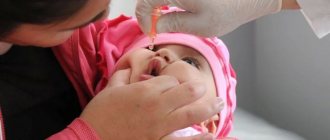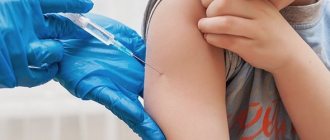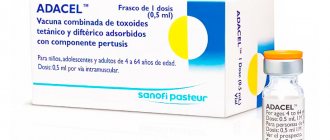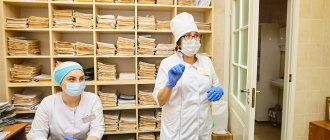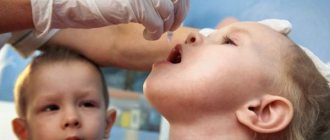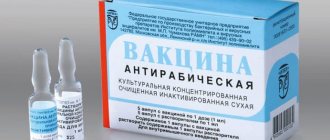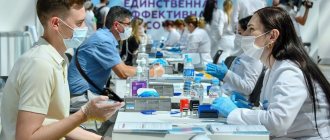In the 1980s, polio was a very common disease in North America and European countries. Since 1988, by decision of the World Health Assembly, the global elimination of this dangerous infection began. As a result of immunization of the population, the incidence rate has decreased worldwide by 99%. By 2010, incidence remained high only in Pakistan, Afghanistan and India. In 2015, the New National Calendar of Russia introduced mandatory vaccination against polio for children starting at 3 months of age.
Nowadays in Russia there is a debate on the issue of vaccination against this disease. The media publishes information about the serious consequences of vaccination against polio with a live vaccine. The dangerous possibility of vaccine-associated paralytic polio (VAPP) is being discussed. Let's clarify this situation and find out what it is - vaccine-associated polio, after which vaccinations does it develop? What are the statistics of vaccine-associated polio in the Russian Federation?
Poliomyelitis - what kind of disease is it?
The causative agent of the disease is poliovirus. The incubation period is 1–2 weeks. The source of infection is a sick person or a carrier of the virus of this disease. The patient excretes the virus in urine, feces, and from the nasal mucosa for 7–14 days.
The virus carrier releases viruses in feces for 5 months. The virus is transmitted through the air with saliva particles during conversation, coughing, and also through the fecal-oral route when using household items (dishes, toys, towels).
The virus enters the human stomach and intestines from contaminated objects. In the body, the virus enters the central nervous system through the blood and lymph. In the gray matter of the spinal cord it causes destruction, which leads to paresis and paralysis.
How are polio vaccines different?
There are 2 types of vaccines to prevent polio.
- A live oral vaccine that contains a weakened virus. This vaccine can cause vaccine-associated polio. It is administered by instillation into the mouth of children.
- Inactivated vaccines, such as Pentaxim, Imovax Polio. They contain killed polio virus.
The advantages of inactivated vaccines are as follows:
- complete exclusion of the development of vaccine-associated poliomyelitis;
- no side intestinal disorder;
- development of 100% immunity.
Consequences of using a live oral vaccine:
- the ability to cause vaccine-associated paralytic poliomyelitis;
- the risk of infecting others after vaccination, since after vaccination the child secretes live virus from the nasopharynx and feces for 2 months;
- development of intestinal disorders.
Signs and forms of VAPP in children
Vaccine-associated polio in children develops after the child is vaccinated with a live vaccine, which is administered by instillation into the mouth. VAPP most often develops in infants with weakened immune systems or immunodeficiency. Symptoms of vaccine-associated polio in children appear at different periods of time depending on the route of infection:
- after vaccination with a live vaccine, signs of vaccine-associated poliomyelitis may appear from 4 to 30 days;
- after contact with a person vaccinated with a live vaccine, symptoms of vaccine-associated poliomyelitis appear within 2 or 3 months;
- In immunocompromised individuals, symptoms may appear even after six months.
Based on the severity of the course, there are 3 forms of VAPP.
- Abortion form - mild degree. Recovery occurs within a month.
- The paralytic form is characterized by the development of paralysis, combined with increased fragility of bone tissue.
- Disability of the patient due to severe muscle atrophy or death.
Symptoms of the abortive form of vaccine-associated polio:
- increased body temperature;
- cough, runny nose;
- headache;
- dyspeptic disorders;
- insomnia or drowsiness;
- muscle twitching;
- back pain in the spine and limbs.
Symptoms of the disease disappear within 1 month.
In the paralytic form of vaccine-associated polio in children, paresis and paralysis of various muscle groups develop against the background of a reduced temperature. The muscles of the thigh are most often affected, less often the neck and torso, and the diaphragm. The child is unable to move his limbs normally.
In the stem form, the muscles of the tongue, pharynx, neck and face are affected. The child is unable to even hold his head up. After 2 weeks, muscle atrophy develops, followed by joint dislocations.
Recovery of paresis occurs very slowly over six months. After this period, persistent muscle atrophy and contracture remain. The joints do not straighten or bend. Then paralysis, kyphoscoliosis (curvature of the spine), shortening and deformation of the paralyzed limb develop.
In case of damage to the muscles of the diaphragm and abdominal muscles, death occurs in 10–25% of cases.
Signs and symptoms of vaccine-associated polio in children
VAPP develops extremely rarely. The incubation period lasts from 5 to 30 days. In people with immunodeficiency, pathological signs may begin to appear six months after vaccination. Symptoms depend on the type of pathology and the state of the person’s immune system.
Doctors identify the following forms of VAPP:
- inapparent . There are no signs of illness. The polio virus is only detected in blood test results. This type of pathology is rare;
- visceral . This is the more common type of VAPP. The victim experiences hyperthermia, sore throat, nausea, cough, rhinitis and diarrhea. A week later everything goes away;
- non-paralytic . The same symptoms occur as with the visceral form, but they are more pronounced. Also, this type of VAPP is characterized by neurological manifestations and tension in the neck muscles. Severe headaches without paralysis are observed. Recovery occurs after a month;
- paralytic _ The most dangerous and severe type of VAPP. The pathology begins with cold symptoms. Then the state of health begins to rapidly deteriorate: episodes of loss of consciousness, delirium, and convulsive seizures appear. When running a finger along the spine, the victim experiences severe pain. When one-fourth of all nerve cells die, paralysis of the arms or legs occurs. Complete immobility occurs only in 1% of cases. Atrophy of the muscles of the respiratory system is considered life-threatening.
According to statistics, 2/3 of children have a fever at the beginning of the development of pathology. Intestinal syndrome is observed in 1/3 of victims. Sluggish paresis is observed on the fifth day of illness. They are durable and last for two months. VAPP most often occurs in infants.
Many parents think that deterioration in health is associated with ARVI until the child develops paralysis. In severe cases, when the respiratory system is involved in the pathological process, the person may die.
Vaccine-associated polio in adults
Adults suffer from polio relatively rarely. Most often they become infected from a sick child. In case of infection with a wild virus, the child is contagious for 2 weeks. In immunocompromised individuals, infection can occur from a child vaccinated with a live oral vaccine. After all, after vaccination, a child secretes the virus from the nasopharynx and feces for 2 months.
The symptoms and course of vaccine-associated polio in adults are the same as in children. Those infected with serious consequences include people with weakened immune systems, those with cancer, and HIV-infected people.
Can vaccine-associated polio develop in unvaccinated children?
Unvaccinated children are also at risk of developing vaccine-associated polio. This is possible if an unimmunized child comes into contact with a recently vaccinated OPV.
Live vaccines contain weakened viruses. After the administration of such a drug, a person begins to secrete bacilli for some time. These vaccine pathogens are too few to infect a healthy child, but are sufficient for an immunocompromised person to develop contact VAPP.
A person vaccinated with OPV poses a danger to weakened individuals for two months after the procedure. For healthy people, contact with a recently vaccinated person can be beneficial: they receive a dose of viral strains, which helps maintain immunity.
If the OPV vaccine was given to a person with a low protective barrier, then he may develop VAPP. In this case, the patient poses a threat even to healthy individuals. After infection, an unvaccinated person develops all the signs of vaccine-associated polio.
It should be noted that the probability of getting sick after vaccination or contact with an immunized person is 5%. In this case, the child is unlikely to get a paralytic form. Most likely, the pathology will be asymptomatic or with mild manifestations of ARVI.
In order to protect against infection, experts give the following recommendations to weakened individuals:
- for a period of up to two months, do not contact a recently vaccinated person;
- take immunostimulating drugs if the OPV vaccinated person is a family member.
The risk of developing contact paralytic VAPP is 2%.
Diagnosis of vaccine-associated polio
A diagnostic study is carried out on the basis of residual paresis 2 months after vaccination with a live vaccine and the absence of contact with the patient. Neurological examination is confirmed by laboratory data.
With vaccine-associated polio, an increased erythrocyte sedimentation rate and leukocytosis (increased number of white blood cells) are detected in the blood. The cerebrospinal fluid reveals an opalescent (shimmering, iridescent) hue, an increased amount of mononuclear cells and protein up to 500 mg. A stool test reveals types 1 and 2 viruses.
Diagnosis and treatment of VAPP in children vaccinated with live vaccine
Symptoms of vaccine-associated polio are similar to those of other diseases caused by herpesviruses and enteroviruses.
VAPP is very similar to Guillain-Barré syndrome, a transverse myelitis. Therefore, the primary task of the physician is to differentiate the pathology.
For this purpose, laboratory diagnostic methods are used. To do this, a swab from the nasopharynx, a portion of blood or a sample of stool is taken and a study is carried out. This allows you to confirm the diagnosis.
With viral carriage, pathogens are detected in human feces and smears. With VAPP, an increased erythrocyte sedimentation rate and leukocytosis are detected in the blood. An excess amount of protein and mononuclear cells is detected in the cerebrospinal fluid.
The doctor also pays attention to the visual manifestations of the disease:
- descending paralysis;
- high temperature;
- decreased tendon reflexes.
If vaccine-associated poliomyelitis is suspected, the victim is hospitalized in an infectious diseases hospital. Treatment is carried out only in a hospital setting. There is no therapy to address the cause of VAPP. Therefore, all actions of doctors are aimed at relieving negative symptoms.
Drug Proserin
The following drugs are prescribed:
- Prozerin;
- Securinin;
- Gamma globulin;
- Galantamine.
Physiotherapeutic techniques are used to rehabilitate people with paralysis. Exercise therapy helps to restore the activity of movements. To improve blood circulation, performing passive exercises is recommended.
Treatment of vaccine-associated polio
There is no etiotropic treatment (aimed at eliminating the cause of the disease). Symptomatic drug therapy is used in treatment. Gamma globulin, securinin, Proserin, galantamine are prescribed.
Rehabilitation of patients with paralysis includes physiotherapeutic methods of therapy. After active movements are restored, exercise therapy is applied. To improve blood circulation in patients with paralysis, passive movements are indicated. Physiotherapeutic procedures in the area of the anterior chest help prevent atelectasis - collapse of the lung lobe.
Statistics of vaccine-associated polio in Russia
According to statistics, 86 cases of vaccine-associated polio were identified in Russia from 1998 to 2004. In 22 cases, vaccine-associated poliomyelitis developed in unvaccinated children. They became infected from people who were vaccinated with a live oral vaccine.
On average, vaccine-associated polio after a live vaccine in Russia occurs in 1 case out of 9 million. In 2004, 15 cases of vaccine-associated polio were recorded in Russia. In 2006, there were 1.5 cases of VAPP per 100,000 population in children under 14 years of age. In 2015–2016, exact statistics have not been published, but on the Internet there is data on the development of VAPP with a frequency of 1 case in 1–3 million after the first vaccination and 1 in 6–12 million from repeated vaccinations.
According to Professor V.M. Studenikin, vaccine-associated polio may completely disappear if exclusively inactivated polio vaccines are used to prevent the disease, without the use of live vaccines.
Morbidity statistics in Russia and the world
In Russia, official recording and monitoring of post-vaccination complications has been carried out since 1998.
Similar work is carried out by specialists from national scientific institutes and WHO experts. But the situation is analyzed mainly in the capital and large cities. According to statistics, from 1998 to 2004, 86 cases of VAPP development were identified in the country.
About twenty children were unvaccinated against a dangerous viral disease and became infected from persons who received a dose of OPV. According to experts, VAPP after a vaccine occurs in 1 case out of 9 million.
In 2004, 15 episodes of VAPP were reported. In 2006, the probability of developing vaccine-associated polio in children under 14 years of age was 1-2 cases per 100 thousand vaccinated.
No statistics were published in 2015-2016. According to data obtained from the Internet, the incidence of VAPP during this period was 1 episode per 1-3 million people. Today, the likelihood of contracting polio from a vaccinated person is even lower.
This statistics is explained by the fact that many parents began to prefer inactivated vaccinations. Globally, vaccine-associated polio occurs with a probability of one case per 4 million vaccinated people.
Professor Studenikin V.M. believes that the risk of developing VAPP will be zero if prevention is carried out only by IPV.
Measures to prevent VAPP
If there is a patient in the home who has received a live vaccine, the entire family should take precautions. After all, poliovirus spreads from contaminated hands and from the nasopharynx to household items, dishes, and clothing within 2 months. If infected with a wild virus, the patient is contagious for 2 weeks. Virus carriers shed the virus in their feces for up to 5 months.
During contact, talking and using household items, family members can become infected with polio. To avoid infection, the entire family should wash their hands thoroughly with soap. Wash dishes with hot water and detergents. It is recommended to ventilate the room several times a day and wet clean the apartment. You cannot kiss a child on the lips.
In conclusion, let us recall that in some cases, after vaccination with a live oral vaccine, paralytic poliomyelitis develops. Such cases give parents a reckless reason to refuse vaccinations against this terrible disease. Nowadays, almost all countries of the world have abandoned the use of live oral vaccines and switched to using vaccines that contain a killed virus. Such vaccines include Imovax Polio and Pentaxim. They are safe at any age, do not cause paralysis after vaccination and develop 100% immunity. The decision to use only inactivated vaccines in injectable form in Russia has already been made at the federal level.
